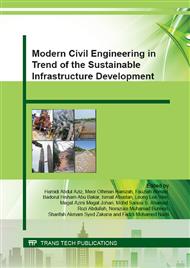[1]
H. Yang, T. An, G. Li, W. Song, W.J. Cooper, H. Luo and X. Guo, Photocatalytic degradation kinetics and mechanism of environmental pharmaceuticals in aqueous suspension of TiO2: a case of β-blockers, Journal of Hazardous Materials, 179 (2010).
DOI: 10.1016/j.jhazmat.2010.03.079
Google Scholar
[2]
S. Basha, D. Keane, K. Nolan, M. Oelgemöller, J. Lawler, J.M. Tobin and A. Morrissey, UV-induced photocatalytic degradation of aqueous acetaminophen: the role of adsorption and reaction kinetics, Environmental Science and Pollution Research, (2014).
DOI: 10.1007/s11356-014-3411-9
Google Scholar
[3]
V. Maroga Mboula, V. Hequet, Y. Gru, R. Colin and Y. Andres, Assessment of the efficiency of photocatalysis on tetracycline biodegradation, Journal of hazardous materials, 209 (2012) 355-364.
DOI: 10.1016/j.jhazmat.2012.01.032
Google Scholar
[4]
L. Yang, L.E. Yu and M.B. Ray, Photocatalytic oxidation of paracetamol: dominant reactants, intermediates, and reaction mechanisms, Environmental science & technology, 43 (2008) 460-465.
DOI: 10.1021/es8020099
Google Scholar
[5]
J. An, Q. Zhou, F. Sun and L. Zhang, Ecotoxicological effects of paracetamol on seed germination and seedling development of wheat (Triticum aestivum L. ), Journal of Hazardous materials, 169 (2009) 751-757.
DOI: 10.1016/j.jhazmat.2009.04.011
Google Scholar
[6]
N. Muir, J. Nichols, M. Stillings and J. Sykes, Comparative bioavailability of aspirin and paracetamol following single dose administration of soluble and plain tablets, Current medical research and opinion, 13 (1997) 491-500.
DOI: 10.1185/03007999709113322
Google Scholar
[7]
J.A. Forrest, J. Clements and L. Prescott, Clinical pharmacokinetics of paracetamol, Clinical pharmacokinetics, 7 (1982) 93-107.
DOI: 10.2165/00003088-198207020-00001
Google Scholar
[8]
C. Usher, M. Teeling, K. Bennett, B. McGowan and J. Feely, Usage of paracetamol‐containing combination analgesics remains high in primary care, British journal of clinical pharmacology, 60 (2005) 648-652.
DOI: 10.1111/j.1365-2125.2005.02500.x
Google Scholar
[9]
S. Wu, L. Zhang and J. Chen, Paracetamol in the environment and its degradation by microorganisms, Applied microbiology and biotechnology, 96 (2012) 875-884.
DOI: 10.1007/s00253-012-4414-4
Google Scholar
[10]
M. Abellán, B. Bayarri, J. Giménez and J. Costa, Photocatalytic degradation of sulfamethoxazole in aqueous suspension of TiO2, Applied Catalysis B: Environmental, 74 (2007) 233-241.
DOI: 10.1016/j.apcatb.2007.02.017
Google Scholar
[11]
M. Abellán, J. Giménez and S. Esplugas, Photocatalytic degradation of antibiotics: the case of sulfamethoxazole and trimethoprim, Catalysis Today, 144 (2009) 131-136.
DOI: 10.1016/j.cattod.2009.01.051
Google Scholar
[12]
S. Fukahori, T. Fujiwara, R. Ito and N. Funamizu, Photocatalytic decomposition of crotamiton over aqueous TiO2 suspensions: Determination of intermediates and the reaction pathway, Chemosphere, 89 (2012) 213-220.
DOI: 10.1016/j.chemosphere.2012.04.018
Google Scholar
[13]
Y. Ji, L. Zhou, C. Ferronato, X. Yang, A. Salvador, C. Zeng and J.M. Chovelon, Photocatalytic degradation of atenolol in aqueous titanium dioxide suspensions: kinetics, intermediates and degradation pathways, Journal of Photochemistry and Photobiology A: Chemistry, 254 (2013).
DOI: 10.1016/j.jphotochem.2013.01.003
Google Scholar
[14]
G. Lofrano, L. Rizzo, M. Grassi and V. Belgiorno, Advanced oxidation of catechol: A comparison among photocatalysis, Fenton and photo-Fenton processes, Desalination, 249 (2009) 878-883.
DOI: 10.1016/j.desal.2009.02.068
Google Scholar
[15]
A.O. Ibhadon, P. Fitzpatrick, Heterogeneous photocatalysis: recent advances and applications, Catalysts, 3 (2013) 189-218.
DOI: 10.3390/catal3010189
Google Scholar
[16]
D. Bahnemann, Photocatalytic water treatment: solar energy applications, Solar energy, 77 (2004) 445-459.
DOI: 10.1016/j.solener.2004.03.031
Google Scholar
[17]
S. Kansal, M. Singh and D. Sud, Studies on photodegradation of two commercial dyes in aqueous phase using different photocatalysts, Journal of hazardous materials, 141 (2007) 581-590.
DOI: 10.1016/j.jhazmat.2006.07.035
Google Scholar
[18]
L. Yang, E.Y. Liya and M.B. Ray, Degradation of paracetamol in aqueous solutions by TiO2 photocatalysis, Water Research, 42 (2008) 3480-3488.
DOI: 10.1016/j.watres.2008.04.023
Google Scholar
[19]
N. Jallouli, K. Elghniji, H. Trabelsi and M. Ksibi, Photocatalytic degradation of paracetamol on TiO 2 nanoparticles and TiO2/cellulosic fiber under UV and sunlight irradiation, Arabian Journal of Chemistry, (2014).
DOI: 10.1016/j.arabjc.2014.03.014
Google Scholar
[20]
R.A. Al-Rasheed, Water treatment by heterogeneous photocatalysis an overview, in: 4th SWCC Acquired Experience Symposium, Jeddah. Domain site: http: /www. swcc. gov. sa, (2005).
Google Scholar
[21]
R.A. Palominos, M.A. Mondaca, A. Giraldo, G. Peñuela, M. Pérez-Moya and H.D. Mansilla, Photocatalytic oxidation of the antibiotic tetracycline on TiO2 and ZnO suspensions, Catalysis Today, 144 (2009) 100-105.
DOI: 10.1016/j.cattod.2008.12.031
Google Scholar
[22]
E.S. Elmolla, M. Chaudhuri, Degradation of amoxicillin, ampicillin and cloxacillin antibiotics in aqueous solution by the UV/ZnO photocatalytic process, Journal of hazardous materials, 173 (2010) 445-449.
DOI: 10.1016/j.jhazmat.2009.08.104
Google Scholar


